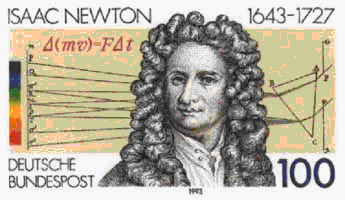|
Newton's
Laws
In
order to quantify the behavior of human-powered devices it will be adequate
to use the description provided by classical mechanics. In about 1686 Newton
formulated the results of many experimental observations in the form of
three "Laws" that describe the expected behavior of relatively large objects.
The
first law places a body in a state of rest, or in uniform motion, unless
it is acted on by a net force that can change this state.
The
second law, shown on the postage stamp, describes the effect of a force,
F, acting on a body of mass, m, moving with a velocity, v, for a time Dt.
The law states that the effect of the force is to change the momentum,
mv, of the body as a function of time such that:
D(mv)
= FDt
or,
taking the mass to be constant and recognizing the quantity (Dv/Dt)
as the acceleration, a, of the body: F
= ma = m(dv/dt).
The
third law states that if two bodies interact the forces between them are
of equal magnitude and opposite direction. |
|
|
|
|
|
|
|
|
|
|
|
|
